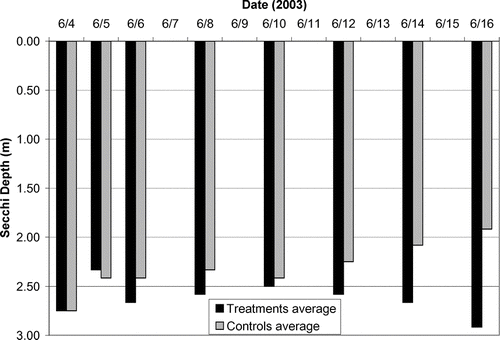Abstract
Microfloc alum injection, in contrast to whole-lake alum treatments, is a relatively new technique for alum delivery that has been implemented in a relatively small number of lakes and reservoirs. Microfloc alum injection is primarily designed to precipitate phosphorus in the water column using low doses applied on a continuous or intermittent basis. The technique employs diffusers to create ultra-small aluminum hydroxide particles with lower settling velocities and longer residence times, compared to whole lake treatments, to strip dissolved phosphorus from the water column. Because relatively few microfloc systems have been deployed, a brief review of their characteristics and performance is provided. In Newman Lake, Washington, a microfloc alum injection system has been in use since spring 1997. We tested microfloc residence times using in situ enclosures; residence time was determined to be at least 10 days, supporting the underlying concept. In the lake itself, turnover events prior to alum injection consistently produced higher algae growth with accompanying lower Secchi transparency. Since alum injection, post-turnover Secchi depths have all improved. In 18 years with 32 monitored turnover events, this relatively robust dataset consistently indicates the short-term ability of microfloc to improve transparency through algae reduction. Volume-weighted total phosphorus concentrations also have generally declined following alum injection. Adverse biological impacts were not observed in either enclosures or the lake. In the enclosure studies, total zooplankton and cladoceran densities and biomass in treatments were not significantly different from controls. Further applications and study of this promising technology are warranted.
Aluminum salts have been used as coagulation and flocculation agents in water clarification for centuries (CitationClark et al. 1998). In lake restoration, whole-lake treatments with aluminum sulfate (alum) have been widely employed since the late 1960s in the United States and Europe (CitationJernelov 1971, CitationDunst et al. 1974, CitationFunk and Gibbons 1978, CitationCooke et al. 2005). Whole-lake alum treatment is widely accepted as a tool for reducing internal phosphorus loading in lakes, with varying durations of effective control (Welsh and Cooke 1999). Actual applications are usually accomplished from a barge or boat, with alum added as a single “dose” over a short period of time, perhaps a few hours or days, depending on lake size.
Newer means of delivery have been developed in which alum can be applied on an intermittent or continuous basis by means of in situ injection apparatus. These applications have been most commonly been employed to control phosphorus in lakes or reservoir inlets. Alum may be injected at varying distances upstream in lake inlets, so that the resultant floc is deposited in the stream channel, in a settling basin or is carried into the lake or reservoir. Alum dosing can be continuous and regulated proportional to flow, or it can be intermittent with injection occurring within specified flow regimes.
Another recent variation on in situ alum injection is the microfloc system, in which alum is applied in low doses by means of a diffusing mechanism. Upon addition to water, alum rapidly hydrolyzes to form colloidal aluminum hydroxide. As long as pH is maintained between about 6 and 8, alum floc is highly effective in precipitating particulate matter, and to a lesser extent, in absorbing and removing soluble materials, such as dissolved phosphate fractions (CitationCooke et al. 2005). Settling rates for alum flocs in conventional treatments are relatively rapid, in the range of m/hr (CitationClark et al. 1998). By contrast, microfloc injection is designed to create the smallest possible aluminum hydroxide colloids, thereby reducing settling velocities and increasing residence time. Greater residence time will increase probability of contact with dissolved as well as particulate phosphates, improving phosphorus removal efficiency in the water column.
In a sense, microfloc alum injection can be viewed as a mirror image of whole-lake alum treatment. While whole-lake treatments are aimed at reducing internal cycling by chemical sequestration (inactivation) of phosphorus in sediments, alum is most often actually applied in the water column. Dramatic short-term water clarification is an often desired and beneficial side effect. In contrast, microfloc alum injection targets suspended particulates and even dissolved phosphorus in the water column. Ultimately, precipitated aluminum will end up in the sediments, where phosphorus sequestration may be regarded as a beneficial side effect. The regulatory approach to these application modes may also be different. For example, in Washington, whole-lake alum treatments have been accomplished with water quality waivers from the state Department of Ecology, while alum injection requires permitting under the National Pollution Discharge Elimination System (NPDES).
Microfloc alum injection has received limited deployment in lakes and reservoirs. Apparently, the first microfloc system was installed in a small lake in Central Park in New York City in the early 1990s, where it was designed to temporarily control external phosphorus loads after the lake was drained and refilled. Details of the sizing and operation are not available, but this system was reported to be highly effective in improving water clarity and was removed when it was deemed unnecessary to maintain water quality (T. Eberhardt, Sweetwater Technology,. 2005, pers. comm.)
Another microfloc system was installed in 1996 in Amesbury Pond, a small, 1.2-ha pond (total volume ∼ 11,000 m3) located in suburban Minneapolis, where it is reportedly still operational. The system consists of an 11-L (30 gal) liquid alum storage tank, with twin peristaltic pumps and distribution lines feeding duel in-lake microfloc diffusers. The system was installed to reduce phosphorus and control growth of a floating macrophyte, Wolffia sp. Alum has been applied during the growing season at annual rates of 365–455 kg (800–1000 lbs) dry alum, or about 33–41 kg (73–91 lbs), as Al. Amesbury pond was also treated with conventional whole-lake treatments in 1996 and 1999. Treatments have been effective in controlling Wolffia sp., although increased growth of submerged macrophytes with the increased water clarity is perceived as a minor problem addressed with herbicide controls. Total phosphorus (TP) has been reduced from a pretreatment high of 160 μ g/L to a range of 20–40 μ g/L (D. Osgood, Osgood Consulting, 2005, pers. comm.).
Microfloc alum systems have also been installed in two New Jersey lakes. Mohawk Lake is a 340-ha (750 acres) lake near Sparta, New Jersey, with high internal and external phosphorus loads. An alum injection system with 21 proprietary microfloc diffusers was installed in 1998 to control phosphorus and reduce nuisance blue-green algae blooms. Total cost for the system was approximately $100,000. Measures of effectiveness include a reported 4-fold increase in water clarity, a 50% reduction in chlorophyll-a, and total phosphorus reduction from a range of about 250 to 50 mg/l (S. Souza, Princeton Hydro Inc., 2005, pers. comm.).
A similar system was installed in the same year at the smaller, 70-ha (150 acre), White Meadow Lake near Rockaway, New Jersey. The White Meadow system utilizes 18 microfloc diffusers and cost about $80,000. Total phosphorus concentration reduction of about 50% has been reported. More recently, microfloc systems have been deployed in Oradelle and Wanaque Reservoirs, but performance data for these installations are not available (S. Souza, Princeton Hydro Inc., 2005, pers. comm.).
A unique microfloc alum injection system was installed in Newman Lake near Spokane, Washington, in April 1997 (Part I, Moore and Christensen 2009). The microfloc system was added as an attachment to a hypolimnetic oxygenator, installed in 1992. The oxygenator represents the first application of down-flow bubble contact technology (Speece Cone) for lake restoration and uses an in-lake pump to move water through the system (CitationMoore 2003). Availability of this pump, which can be run with or without oxygen addition, permitted “piggy-backing” microfloc injection on the oxygenator, with substantial cost savings. Total design and capital costs for the Newman Lake microfloc system were about $35,000 (M. Barrentine, Spokane County Engineers Office, 2008, pers. comm.).
The Newman Lake system uses very different diffusing and distribution mechanisms than other extant microfloc systems. Diffusers are venturi-shaped plastic pipes, about 15.2 cm (6 in) dia and about 35.6 cm (14 in) long (). Alum distribution lines are 1.9 cm (3/4 in) dia black plastic pipes that terminate at metal injection fittings located just downstream of the narrowest portion of the venturi constriction. Each diffuser is bolted to an exit port on the distribution manifold of the Speece cone. The system employs a 23 m3 (6000 gal) storage tank on shore, with a timer-controlled peristalic pump that meters alum to distribution lines supplying two in-lake diffusers. A backup line and diffuser are in place in case of problems with either of the main lines. A submerged 45 kw (60 hp) pump moves water through the Speece cone and manifold. As water exits the manifold outlet ports, it is accelerated through the venturi-shaped diffusers. Alum injection takes place at the point of maximum velocity. High velocity water rapidly dilutes the alum, shearing any floc that forms, and disperses the resulting aluminum hydroxide colloids.
Figure 1 Diagram of alum injector venturi in Newman Lake system: (a) venturi, (b) alum injector, and (c) alum supply line. Arrows indicate direction of flow. Venturi is fitted over outlet port from oxygenation system distribution manifold.
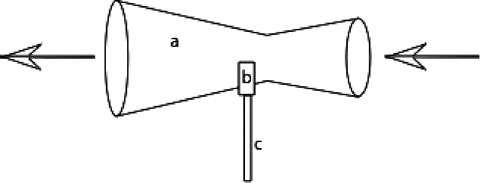
Because the hypolimnetic oxygenation system is designed to avoid disruption of thermal stratification, water is discharged horizontally. Vertical distribution of microfloc alum at Newman Lake is therefore dependent on natural eddy diffusion, presumed to be most significant during lake turnover. For this reason, primary alum addition is allocated for turnover events. Some alum is injected during summer stratification to reduce phosphorus in the hypolimnion that would be available for reintroduction into the photic zone at fall turnover or during entrainment events (see Part I, Moore and Christensen 2009).
Because exact timing and duration of turnover events cannot be predicted precisely, an operational protocol has been developed for allocating limited alum supplies. Because phosphorus mixed into the photic zone during spring is available for epilimnetic summer algae production, spring turnover was assigned highest priority. Fall turnover was allocated second priority, when phosphorus removal would potentially reduce late season algae blooms and winter carryover. Summer stratification injection was assigned lowest priority. Approximately one-third of the total yearly alum supply was allocated to each of these priorities.
Stable thermal stratification in Newman Lake usually develops by mid- to late May. Occasionally, a second spring or even early summer turnover may take place during unseasonably cold and windy weather. The alum prioritization protocol allows shifting of supplies to achieve maximum injection rates because phosphorus reduction during a summer turnover event should have greatest potential for directly impacting summer algae productivity. Overall, the priority allocation system allows flexibility in adapting alum injection to actual environmental conditions determined by lake monitoring so that benefits of limited alum supply on particulate and phosphorus removal may be maximized. In practice, about half of the annual allocation has been utilized in spring and about one-quarter each used for fall turnover and summer stratification ().
Table 1 Annual alum use by season in Newman Lake microfloc injection system, 1997–2007 (Data from M. Barrentine and J. Anderson, Spokane County Engineer's Office, Spokane Washington). All values as hydrated aluminum sulfate.
Efficacy assessment of any new technology or technique is crucial in evaluating applicability for lake restoration or management., Restoration efforts often involve multiple techniques, however, making attribution of specific results to specific actions difficult at best. At Newman Lake, restoration efforts have included various watershed management practices, hypolimnetic oxygenation, whole-lake alum treatment, as well as alum injection. Collectively, these practices have successfully reduced summer algae and blue-green biomass and reduced annual average volume-weighted TP (CitationMoore and Christensen 2009). Although available data are not adequate to totally isolate contributions of each practice to algae and nutrient reduction, it is possible to infer aspects of microfloc alum injection efficacy based on observations of lake processes.
Microfloc alum residence time in Newman Lake was also assessed using in situ mesocosms. Although mesocosm enclosures do not necessarily duplicate open water lake conditions, this study provides a conservative estimate of alum residence time and the potential influence on certain water quality parameters. Actual residence times in more turbulent open water conditions are likely to be enhanced compared to the sheltered enclosures. Other considerations in comparing microcosm results to actual lake conditions is discussed. Plots of growing season and volume-weighted TP concentrations versus injection rates were used to assess alum influence on lake phosphorus. In addition, 18 years of Secchi depth measurements, including readings taken before and after turnover events, allowed assessment of short-term impacts of alum on water clarity.
Methods
The Newman Lake study area and restoration history are detailed in Part I (CitationMoore and Christensen 2009 – might be 2010). Water transparency was assessed using a standard 20-cm diameter Secchi disk, with alternating white and black quadrants. Sampling intervals were approximately every two weeks following spring ice-off, typically in March or April until late October or early November in 1986, from mid-summer 1989–1992, and from mid-summer 1993–2005. Measurements were usually taken close to midday, between 10:00 and 14:00. For most dates, samples were taken at three locations.
Field and laboratory protocols for determination of total and ortho-phosphorus concentrations were discussed in Part I. The alum system was installed in April 1997 and was operational after mid-summer of that year. Rates of alum addition () were based on daily injection logs (M. Barrentine and J. Anderson, Spokane County Engineers Office, 2009, unpubl. data).
Recorded Secchi depths are an average of the depth at which the disk disappears when lowered and reappears when raised. Data reported here are averaged values from three stations, although the majority of Secchi measurements on a given date were identical at all locations. Because the alum is principally injected during turnover, data analysis focused on Secchi readings immediately prior to and immediately following turnover events. Data values for the sampling date closest in time prior to and just after the onset of thermal turnover were used for the analysis.
Enclosure studies
Six limnocorrals 2-m dia by 8-m deep with a total volume of about 25,130 L each were deployed in the experiment. Enclosures were constructed of impermeable, clear polyvinyl chloride (PVC) material, ultra-violet (UV) stabilized to reduce light degradation (Aquatic Research Instruments 2003). Enclosures were suspended from a barge at the Mid-Lake station. After being initially lowered to 6 m, enclosures were left unfurled for about 1 hr. Deployment was then accomplished by extending each enclosure to the surface, where a flotation collar was attached around the upper opening of each. The goal was to include biologic assemblages in enclosures that were as similar as possible to those in the lake (CitationWurtsbaugh et al. 2001). For the final deployment step, enclosure bottoms were closed, while the tops were left open to the atmosphere. Enclosures were allowed to stand overnight before initial sampling.
Microfloc alum injections were simulated in three randomly selected treatment enclosures on the first day after initial sampling. A pump and siphon apparatus pumped water from near the bottom of the enclosures (6 m) to the surface through 2.5 cm i.d. Tygon tubing. Diluted alum was aspirated from a smaller, 0.63 cm i.d. tube into the larger tube before being injected as microfloc just below the water surface. In the three control enclosures, water was pumped in a similar manner, but without alum addition.
Alum doses in each enclosure were based on the maximum allowed daily rate in Newman Lake: 900 lbs (∼ 410 kg) per day, as Al (Washington Department of Ecology, National Pollution Discharge Elimination System permit), multiplied by the expected residence time of alum (10 days) divided by the average volume of the lake (25 × 106 m3). The resulting target concentration (0.163 mg· L− 1 total Al) was then used to calculate the volume of 48.87% alum syrup (specific gravity 1.3282) added to each treatment enclosure (70.25 ml).
The lake was used as a comparison to enclosure conditions and as an additional control. Limnocorral study dates and duration were recorded ().
Table 2 Sampling Schedule.
Chemical samples from the lake and each enclosure were collected from the surface and mid-depth (3 m) in enclosures and from the lake. Water samples were stored in acid-washed Nalgene bottles (darkened for chlorophyll-a), iced during transport and stored at 4 C until analyzed. Temperature, dissolved oxygen (including percent saturation), pH and specific conductivity were measured at 1-m intervals using a Hydrolab Minisonde 4a Water Quality Multiprobe equipped with a Hydrolab Surveyor Model 6 recording device.
Alkalinity samples were collected in 1-L Nalgene bottles and analyzed (as mg· L− 1 CaCO3) within 12 hr of collection by titration with 0.02 N sulfuric acid using 0.05% aqueous methyl orange and 0.5% phenolphthalein indicator w/v alcoholic (APHA 1998).
Total aluminum (Al) was determined using a Varian Liberty II Radial ICP-AES (Inductively-coupled plasma analyzer). The ICP was calibrated with NIST Traceable Standards and calibration verified by use of 1.0 ppm NIST Traceable Quality Control (QC) check standards following calibration.
Chlorophyll-a samples were collected in 250-ml dark-colored bottles and preserved with two drops of magnesium carbonate (MgCO3; Wetzel and Likens 2000). Chlorophyll-a analysis followed EPA Method 445.0 (CitationArar and Collins 1992) and was modified for a nonacidification method using a Turner Designs 700 Fluorometer with a blue mercury vapor lamp, a 436-nm excitation filter and a 680-nm emission filter.
Zooplankton samples were collected every other sampling date (Jun 4, 5, 8, 12 and 16) from each enclosure and the lake by one vertical tow from a depth of 6 m to the surface, using a 1-m long, 75-mm mesh plankton net (30 cm dia). Samples were preserved with 6 ml of 5% buffered formalin added in the field (APHA 1998). Prior to analysis, samples were diluted with distilled water to a final volume of 250 ml. Subsamples (1 ml) were taken with a Hensen-Stempel large bore pipette and transferred to a Sedgewick-Rafter counting slide. Additional subsamples were counted until a stable coefficient of variation (standard deviation divided by the mean) of < 30% was achieved (Downing and Rigler 1984, CitationBerthouex and Brown 2002). Identifications, counts and measurements were performed with a Leica binocular compound microscope equipped with a micrometer-calibrated eyepiece. Daphnia were identified to species using the taxonomic keys of CitationThorp and Covich (2001) and CitationPennak (1989). Other zooplankton groups, including cladocerans, copepods and rotifers were identified to genus.
Total zooplankton density per sample was calculated using the relationships detailed in CitationWetzel and Likens (2000). Zooplankton densities for subcategories, including cladocerans, copepods and rotifers were also determined. Cladoceran biomass (B) was estimated by combining the number of individuals (N) of a species (density) and their average mass (M) in the form: B = N × M. Individual mass estimates were derived from length-weight regression equations summarized by CitationMcCauley (1984).
Treatment (#1) and control (#2) enclosures were compared for significant differences in physical, chemical and biological characteristics throughout the post treatment study period using Minitab 15 statistical analysis software (Minitab Inc., State College, PA). An analysis of variance (ANOVA) general linear model (GLM) was used to compare data between the treatments and controls (significance level = 0.05) in an unbalanced design (Minitab 2003). In some cases, the GLM was employed to detect significant differences between lake data (treatment 3) and treatment or control enclosure data (or both).
Results and discussion
Enclosure experiments
Thermal stratification was evident in the lake prior to initiation of the experiment. Temperature profiles in the lake and enclosures were similar throughout the study (p = 0.927). Greatest temperature change was between 3 and 4 m. Significant differences in dissolved oxygen concentrations between enclosures and the lake were not detected (p = 0.163; p = 0.156, respectively). Initial specific conductivity values in the lake and enclosures were about 41−43 mS/cm. Alum treatment increased specific conductivity to 44−47 mS/cm, and these values were significantly different from those in untreated enclosures and the lake (p = 0.003).
Initial enclosure and lake pH values were similar, ranging from 7.3 to 7.9 at the surface and from 6.6 to 6.7 at 6 m. Control and treatment pH differed significantly after the initial sampling day (p = 0.007). In the treatments, surface pH values decreased to 6.8–7.1 within hours after alum addition then increased to about 7.2–7.4 by the end of the study. In controls, pH was relatively constant then increased toward the end of the study, with values ranging from 7.8 to 9.1 at the surface and from 8.4 to 9.2 at 1-m depth.
Average alkalinity values for surface and mid-depth treatment samples () show that alkalinity was significantly different between surface and mid-depth samples (p = 0.001) and between enclosure treatments for both surface and mid-depths (p = 0.001; p = 0.012, respectively). In the top samples, alkalinity decreased immediately after alum treatment, dropping from a range of 15.3–16.2 mg· L− 1 CaCO3 before treatment to 10.3–12.0 mg· L− 1CaCO3 after treatment. In the mid-depth samples, initial values ranged from 15.7 to 15.8 mg· L− 1CaCO3. Alkalinity in the mid-depth treatment enclosures did not decrease until one full day after alum treatment. Minimum alkalinity at the mid-depth was 14.1 mg· L− 1CaCO3, measured on the third day after treatment. After the initial declines, alkalinity recovered to almost pretreatment levels by the end of the study.
Figure 2 Average alkalinities, in mg/L, as CaCO3 for surface and mid-depth samples in alum treatment enclosure experiments in Newman Lake.
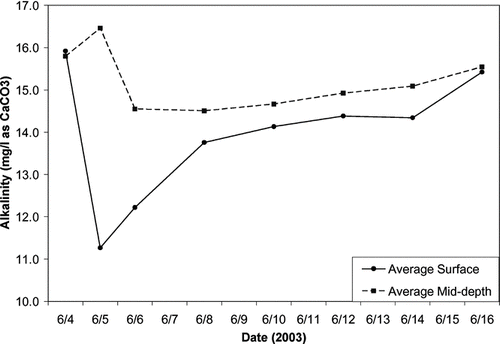
Settling of alum floc is evident from average total surface and mid-depth aluminum concentrations for treatments and controls over the course of the experiment (). As expected, alum injection produced statistically significant increases in aluminum concentrations compared to controls (p = 0.001) between surface and mid-depth samples (p = 0.028), as well as significant interaction between treatment and depth (p = 0.001). High surface aluminum concentrations were observed within hours of alum treatment (0.638–0.967 ppm). Aluminum concentrations peaked on day 1, remaining concentrated at the surface for the first 2–3 days. Average surface concentrations decreased by about half on each of the subsequent sample days 2 and 4 and then declined at a slower rate through the remainder of the experiment. In the mid-depth samples on day 4, aluminum concentrations increased to a range of 0.090–0.144 ppm, while average surface total aluminum concentrations declined to < 0.2 ppm (range 0.090–0.239 ppm). Surface aluminum remained at about 0.1 ppm through day 10. By day 12, surface aluminum decreased to the < 0.01–0.075 ppm range but was still higher than in controls (< 0.01 ppm). Mid-depth aluminum peaked on day 6 at an average of 0.13 ppm (range 0.119–0.163 ppm) and then decreased to < 0.07 ppm by day 12. Control values remained < 0.03 ppm for the entire experiment.
Figure 3 Average total aluminum in mg/L (ppm), as Al, in surface and mid-depth samples for treatment and controls from Newman Lake enclosure experiments.
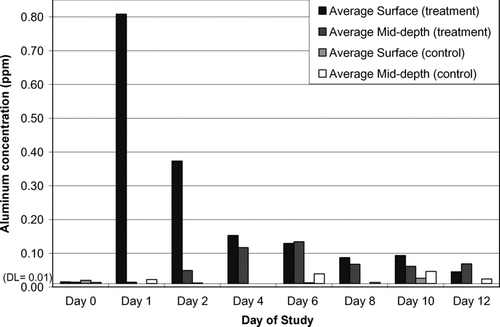
Concentrations of TP in the lake and enclosures during the course of the experiment ranged from 13 to 56 μ g/L(). Total phosphorus was statistically different between treatments and controls (p = 0.065), although this difference was not robust for surface and mid-depth samples combined. However, for surface samples alone, differences between treatment and control TP were statistically significant (p = 0.017). Average TP concentrations in surface samples in treatment and control enclosures and for the lake were similar until about day 4 when the respective concentrations began to diverge. Treatment TP concentrations were also statistically lower than both the lake and controls in combination (p = 0.036).
Figure 4 Average surface total phosphorus in alum, control and lake during Newman Lake enclosure experiments. All TP values in mg/L (ppm), as P. Treatment 1 = alum treated enclosures; Treatment 2 = control enclosures; Treatment 3 = lake.

The TP in mid-depth samples was lower in treatments than in controls, although the overall differences were not statistically significant (p = 0.307). However, a significant difference was found between treatments and controls at the end of the experiment using data from days 10–12 (p = 0.019). Overall, TP in the control enclosures was significantly higher than the lake (p = 0.001), while TP in the treatment enclosures was not significantly different from the lake (p = 0.090). On the final day of the study the average estimated total mass of phosphorus in the treatment enclosures was 553 mg, or about 29% lower than that in the control enclosures (779 mg).
Chlorophyll-a concentrations in the surface and mid-depth samples ( and , respectively) show that following alum treatment, chlorophyll-a was significantly different between treatments (p = 0.022), with the main effect starting on study day 6 when the control values increased significantly (range 4.1–7.0 μ g/L) and the treatment values remained low (range 2.4–4.6 μ g/L). By the end of the study, treatment chlorophyll-a averaged around 4 μ g/L, (range 1.7–7.7 μ g/L), while average control chlorophyll-a was 12 μ g/L (range 3.4–21.1 μ g/L). Analyzing surface and mid-depth samples separately, the differences between enclosure treatments were also significant (p = 0.022; p = 0.035, respectively). In the surface samples, this difference became evident on day 4, while in the mid-depth samples the difference was noted on day 6. Overall, there was no significant difference in chlorophyll-a between the treatment enclosures and the lake (p = 0.620), but chlorophyll-a was significantly higher in the control enclosures than in the lake (p = 0.003). On the final day of the study the average mass of chlorophyll-a in the treatment enclosures (108 mg) was 62% lower than in the control enclosures (284 mg), and this appears to be reflected in higher Secchi depths in treatments versus controls ().
Figure 5 Average surface chlorophyll-a (μ g· l− 1) in alum, control, and lake during Newman Lake enclosure experiments. Treatment 1 = alum treated enclosures; Treatment 2 = control enclosures; Treatment 3 = lake.
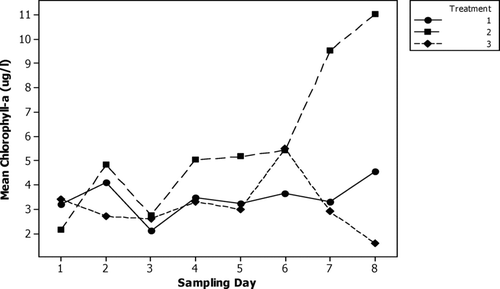
Figure 6 Average mid-depth chlorophyll-a (μ g· l− 1) in alum, control and lake during Newman Lake enclosure experiments. Treatment 1 = alum treated enclosures; Treatment 2 = control enclosures, Treatment 3 = lake.
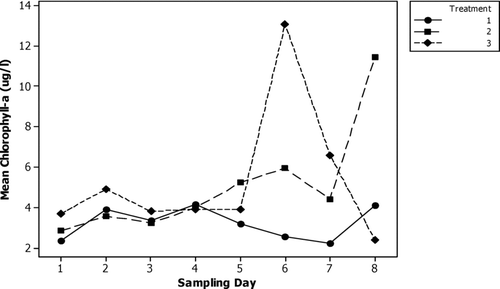
Microfloc treatments in the enclosures did not result in significant changes in zooplankton populations, particularly cladoceran density and biomass. For all zooplankton parameters (total zooplankton density, copepod density, rotifer density, cladoceran density and cladoceran biomass), we found no significant differences between enclosure treatments ( and ). There was a general decrease over time in all the enclosures, but this trend followed similar decreasing trends in the lake and were therefore most likely part of the natural zooplankton community trajectory in the lake at the time of study.
Figure 8 Average total zooplankton density (individuals· m− 3) vs. sampling day. Treatment 1 = alum treated enclosures; Treatment 2 = control enclosures; Treatment 3 = lake.

Figure 9 Average cladoceran density (individuals· m− 3) vs. sampling day. Treatment 1 = alum treated enclosures; Treatment 2 = control enclosures; Treatment 3 = lake.
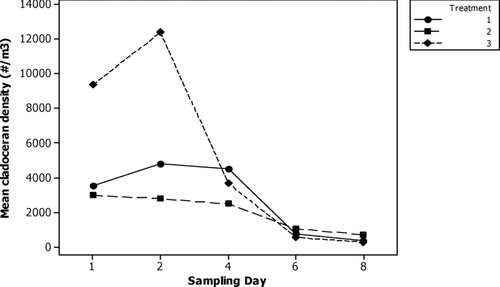
Zooplankton densities were considerably higher in the lake than in the enclosures, possibly due to the filling method in which enclosures were pulled up from a depth of 6 m, whereas zooplankton densities may have been greatest at the lower depths (6–8 m) on the morning of deployment. Marked diel vertical migration, triggered by changes in light intensity, is very common among cladoceran zooplankton, and to a lesser extent the copepods (CitationWetzel 2001). Most species migrate upward from deeper waters to surface strata as darkness approaches and return to deeper strata at dawn (CitationWetzel 2001).
Taken together, the data demonstrate that microfloc alum treatments did not have a significant effect on zooplankton populations over the 8 days of assessment. Thus far, no evidence suggests that microfloc alum injection produces adverse impacts on lake zooplankton. In fact, results from most whole-lake alum treatment studies do not indicate that zooplankton was harmed. Often, improved water quality following alum treatment also improves zooplankton populations (CitationMires et al. 1981, CitationSchumaker et al. 1993, CitationHolz and Hoagland 1999). Studies on more subtle effects, such as life cycle interactions, are certainly warranted (e.g., CitationWold et al. 2005).
Long-term lake studies
Secchi depths were reported prior to and following all turnover events from 1986 to 2007 for which monitoring data are available (). Changes in Secchi depth were reported as negative numbers when transparency decreased and as positive numbers to designate increases. In the 16 turnover events monitored in the years prior to installation of the alum system, visibility decreased after turnover, with decreases in transparency ranging from −0.3 to −1.3 m (average change = −0.7 m). After installation of the alum system, changes in Secchi depth following turnover (21 events) were all positive, with increases ranging from 0.2 to 1.6 m. Average increase in Secchi depth with alum injection was 0.7 m ().
Figure 10 Net change in Secchi depth at turnover for Newman Lake 1986–2007. All years and seasons for which data are available are included. Microfloc system installed in spring 1997. Y-axis values in meters.
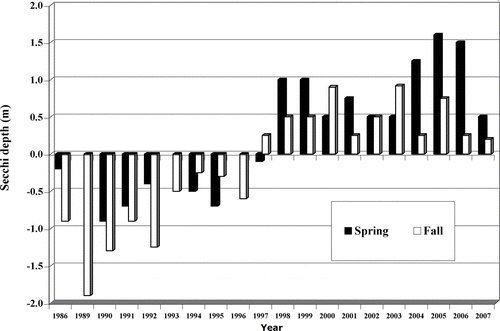
Secchi depth in Newman Lake correlates well with phytoplankton biomass, the predominant particulate material in the lake (CitationFunk et al. 1976, CitationFunk and Moore 1988, CitationMoore 2003). An exception to this was in April 1997, when a 30-yr or greater flood event transported substantial amounts of eroded soils into the lake. The flood event happened to correspond with the time of installation of the microfloc system.
After every turnover event prior to alum injection, algal biomass increased, as indicated by decreased Secchi depth. Algae were most likely stimulated by increased nutrient availability resulting from mixing of nutrient-rich bottom waters into the euphotic zone. In contrast, water clarity improved after every turnover event following alum injection, probably due to decreased algae concentrations. The most likely mechanism is flocculation and precipitation of algae cells. In addition, sequestration and removal of phosphorus from the water column possibly reduced availability for phytoplankton growth. The results, both with and without alum, are consistent; all events prior to alum injection produced decreased Secchi depth, and all events after alum injection show enhanced transparency.
Volume-weighted lake TP concentrations and alum injections from May 1997 through August 2007, expressed as sums of daily doses for the previous 14 days (), show a general pattern of decreasing total phosphorus following alum dosing. Higher and longer dosing in spring typically reduced spring high TP levels through the summer, and TP generally increased again with fall turnover. Responses to fall alum injection are less clear, especially because monitoring usually did not extend beyond the period of alum injection into late fall or early winter. For the years in which later phosphorus data are available, such as 1998, 1999, and 2002, there is an indication of increasing TP after cessation of alum addition.
Figure 11 Microfloc alum injection rates and volume-weighted total phosphorus in Newman Lake 1997–2007. Alum injection rates are calculated as total kg added over a 14-day period. Volume-weighted total phosphorus is calculated by integration of the sums of concentrations from profiles from three stations, times the respective volumes for the entire lake, divided by total lake volume, to yield an average, expressed in μ g/L.
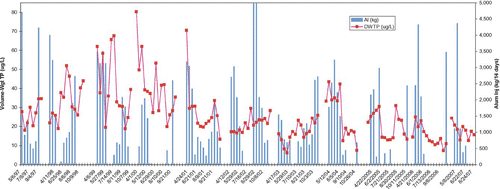
A surprising pattern arose that indicated apparent effectiveness of summer alum additions (). Overall, summer TP increased when alum was not injected or when dosages were low and decreased in years with higher doses. Particularly interesting for comparison are the years 2000, when equipment breakdown precluded alum injection from July through late September, and 2001, when the system was operated according to the prescribed allocation plan. For 2000, high spring TP appears to have responded to high alum dose, but TP increased throughout the summer. There may have been a brief response to an early September alum pulse, but the system was inoperable again until a moderate dose was added in late September. The previous year, 1999, shows a similar pattern, with no to low summer alum doses and corresponding increases in TP.
Although TP in the epilimnion of stratified lakes is often observed to decrease during summer (CitationCooke et al. 2005), the opposite may be true as well. For the Newman Lake watershed in early spring, Thompson Creek discharge is often principally composed of snowmelt-derived water, with temperatures lower than the lake. Under such thermal conditions, inlet waters will layer along the lake bottom; however, as warming of inlet streams generally proceeds through spring and summer, temperature disparities between the lake and inlet waters diminish. External inputs, including phosphorus, during the late season are more likely to be retained within the epilimnion, providing a mechanism for increased epilimnetic TP, proportional to the external load. Therefore, as noted in CitationCooke et al. (2005), summer epilimnetic TP may be strongly influenced by the summer external load in any particular year.
Summer upwelling and vertical entrainment, as described by CitationBlanton (1973), are two processes that result in incorporation of hypolimnetic water, materials and energy into the epilimnion. Both mechanisms are likely significant sources of TP for primary productivity in Newman Lake. Observations of significant turbidity and temperature profiles along the up- and downwind lake margins following summer storm events have been made in most summers, showing the importance of upwelling. This is especially true late in the summer, when thermocline depths are close to the maximum depths of the northern and southern lobes of the lake (see in Moore and Christensen 2009), so that upwelling may impact a relatively large portion of the lake surface area. Vertical entrainment is demonstrated by the consistent pattern of thermocline deepening, observed for every year in which measurements have been made in Newman Lake.
In contrast to 2000, in 2001 there seems to be a significant TP response to alum additions, with low summer doses corresponding with steady TP at very moderate concentrations (approximately 20 μ g/L). Although microfloc injections at Newman Lake take place in the summer hypolimnion and should not directly impact epilimnetic TP, potential mechanisms can explain these observations. As noted previously, vertical entrainment and upwelling could introduce Al into the epilimnion. Alternately, microfloc could reduce the introduction of hypolimnetic TP from these same mechanisms. Internal loading in stratified lakes is typically of lesser importance to summer primary productivity, except in lakes with a low mean depth relative to the surface area, such as Newman Lake. Because mixing depth is a function of the square root of surface area, lakes with a low Osgood Index potentially have a larger fraction involved in mixing (CitationNürnberg 1988, CitationOsgood 1988, CitationWelch and Cooke 1995).
Conclusions and management implications
Alum is a well-established and effective tool for nutrient reduction in lake restoration, with a substantial record of environmental safety. Alum applied in low doses as microfloc seems to produce immediate, short-term improvements in water clarity. Most likely, alum applied in this manner removes particulates such as algal cells, an action that would also reduce TP in the water column. Further sampling is appropriate to determine if microfloc alum is effective for removing dissolved phosphorus components and if the reductions have more long-term benefits in lowered phosphorus availability.
The Newman Lake project, as well as other multiphase microfloc alum injection projects, has been successful in reducing nutrients and algae and in improving water clarity. The enclosure experiments show that aluminum resident time in the water column is close to predicted times, about 10–12 days. Lower settling velocities compared to whole lake treatments offer increased opportunities for aluminum to react with particulate and dissolved phosphorus. For lake managers, microfloc and other in situ systems provide an important new dimension by providing capability of timely response to ambient water quality conditions. These systems offer great flexibility for dosing and timing, which can allow the manager to gain maximum benefit from limited resources by appling alum when, where, and at concentrations to achieve greatest efficacy.
For small lakes, alum injection may be sufficient in itself to accomplish water clarity, algae and nutrient goals. Although in situ systems have not been used as direct replacements for whole-lake treatments, particularly in larger lakes, they do offer a longer-term and more flexible tool for lake managers. The successes to date certainly indicate that additional deployment and continued evaluation of microfloc alum injection systems for lake restoration is appropriate.
Acknowledgements
These papers are dedicated to Dr. William H. Funk, who initiated the Newman Lake restoration efforts, and to his substantial contributions over four decades of service to the cause of lakes, and to NALMS. The authors thank the many residents and property owners at Newman Lake, too numerous to name individually, who have supported restoration and protection of the lake which they love. Marrianne Barrentine and her staff at the Spokane County Engineers Office are thanked for their input and daily work on behalf Newman Lake. The authors thank Gertrud Nürnberg, Dick Osgood, Al Sosiak, and three anonymous reviewers for their valuable comments and critiques.
References
- [APHA] American Public Health Association . 1998 . Standard methods for the examination of water and wastewater, , 20th ed , Washington , D. C. : American Public Health Association .
- Arar , E. J. and Collins , G. B. 1992 . In vitro determination of chlorophyll a and phaeophytin a in marine and Freshwater phytoplankton by Fluorescence. Method 445.0 Version 1.1 (Nov. 1992) , Cincinnati , OH : U. S. Environmental Protection Agency, Environmental Monitoring Systems Laboratory, Office of Research and Development .
- Berthouex , P. M. and Brown , L. C. 2002 . Statistics for environmental engineers , Boca Raton , FL : Lewis Publishers .
- Blanton , J. O. 1973 . Vertical entrainment into the epilimnia of stratified lakes . Limnol. Oceanogr. , 18 ( 5 ) : 697 – 704 .
- Clark , J. W. , Viessman , W. Jr. and Hammer , M. 1998 . Water supply and pollution control , New York , NY : Addison-Wesley .
- Cooke , G. D. , Welch , E. B. , Peterson , S. A. and Nichols , S. A. 2005 . Restoration and management of lakes and reservoirs, , 3rd ed , Boca Raton , FL : Taylor and Francis Group .
- Downing , J. A. and Rigler , F. H. , eds. 1984 . A manual on methods for the assessment of secondary productivity in fresh waters , Oxford , UK : Blackwell Scientific Pub. .
- Dunst , R. C. , Born , S. M. , Uttormark , P. D. , Smith , S. A. , Nichols , S. A. , Peterson , J. O. , Knauer , D. R. , Serns , S. L. , Winter , D. R. and Wirth , T. L. 1974 . Survey of lake rehabilitation techniques and experiences , Madison , WI : Dept. Natural Resources . Technical Bulletin No. 75
- Funk , W. and Gibbons , H. 1978 . Lake restoration by nutrient inactivation Washington , D. C. Lake Restoration: Proc. Nat. Conf. USEPA 440/5-79-001
- Funk , W. , Gibbons , H. , Morency , D. , Bennett , P. , Marcley , R. and Bailey , G. 1976 . Investigation to determine the extent and nature of non-point source enrichment and hydrology of several recreational lakes of eastern Washington. Part II. Water quality studies , Pullman , WA : Washington State University . State of Washington Water Research Center Report No. 26
- Funk , W. and Moore , B. C. 1988 . Newman Lake restoration feasibility study , Pullman , WA : Washington State University . State of Washington Water Research Center Report No. 69
- Holz , J. C. and Hoagland , K. D. 1999 . Effects of phosphorus reduction on water quality: Comparison of alum-treated and untreated portions of a hypereutrophic lake . Lake Reserv. Manage. , 15 : 70 – 82 .
- Jernelov , A. Phosphorus reduction by precipitation with aluminum sulfate . 5th International Conference on Water Pollution Research . Pergammon Press .
- McCauley , E. 1984 . “ The estimation of the abundance and biomass in zooplankton in samples ” . In A manual on methods for the assessment of secondary productivity in fresh waters , Edited by: Downing , J. A. and Rigler , F. H. 228 – 265 . Oxford , UK : Blackwell Scientific . Chapter 7
- Mires , J. M. , Soltero , R. and Keizur , G. R. 1981 . Changes in the zooplankton community of Medical Lake, WA, subsequent to its restoration by a whole-lake alum treatment and the establishment of a trout fishery . J. Freshw. Ecol. , 1 ( 2 ) : 167 – 178 .
- Moore , B. C. Downflow contact bubble aeration technology for sediment oxidation . Proceedings of the Second International Conference on Remediation of Contaminated Sediments . Venice , Italy. Edited by: Pellei , M. and Porta , A. Columbus , OH : Battelle Corporation .
- Moore , B. C. and Christensen , D. 2009 . Newman Lake restoration case study. Part I. Chemical and biological responses to phosphorus controls . Lake Reserv. Manage. , 25 ( 4 ) : 336 – 350 .
- Nürnberg , G. 1988 . Prediction of phosphorus release rates from total and reductant-soluble phosphorus anoxic lake sediments . Can. J. Fish Aquat. Sci. , 45 : 453 – 462 .
- Osgood , R. A. 1988 . Lake mixes and internal phosphorus dynamics . Arch. Hydrobiol. , 113 : 629 – 638 .
- Pennak , R. W. 1989 . Freshwater Invertebrates of the United States, , 3rd ed , New York , NY : Wiley and Sons .
- Schumaker , R. , Moore , B. C. and Funk , W. H. 1993 . Zooplankton responses to aluminum sulfate treatment of Newman Lake, WA . J. Freshw. Ecol. , 8 ( 4 ) : 375 – 378 .
- Thorp , J. H. and Covich , A. P. 2001 . Ecology and Classification of North American Freshwater Invertebrates, , 2nd ed , San Diego , CA : Academic Press .
- Welch , E. B. and Cooke , G. D. 1995 . Internal phosphorus loading in shallow lakes: Importance and control . Lake Reserv. Manage. , 11 ( 3 ) : 273 – 281 .
- Welch , E. B. and Cooke , G. D. 1999 . Effectiveness and longevity of phosphorus inactivation with alum . Lake Reserv. Manage. , 15 : 5 – 27 .
- Wetzel , R. G. 2001 . Limnology, , 3rd ed , San Diego , CA : Academic Press .
- Wetzel , R. G. and Likens , G. E. 2000 . Limnological analyses, , 3rd ed , New York , NY : Springer-Verlag .
- Wold , L. , Moore , B. C. and Dasgupta , N. 2005 . Life history responses of the zooplankter, Daphnia pulex with exposure to aluminum sulfate . Lake Reserv. Manage. , 21 ( 4 ) : 383 – 390 .
- Wurtsbaugh , W. , Gross , H. , Budy , P. and Luecke , C. 2001 . Effects of epilimnetic versus metalimnetic fertilization on the phytoplankton and periphyton of a mountain lake with a deep chlorophyll maxima . Can. J. Fish. Aquat. Sci. , 58 : 2156 – 66 .
